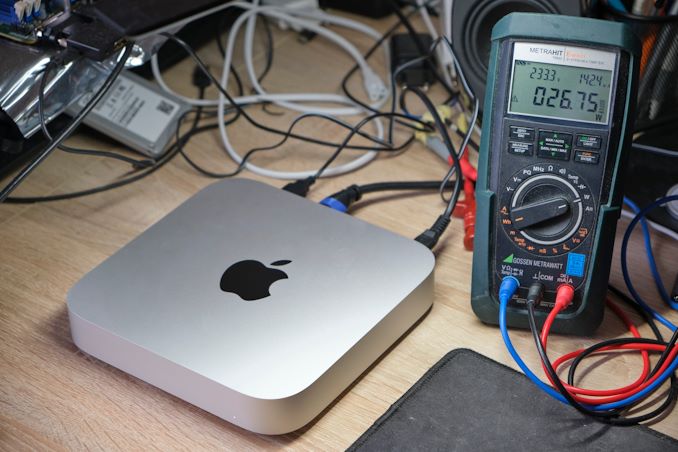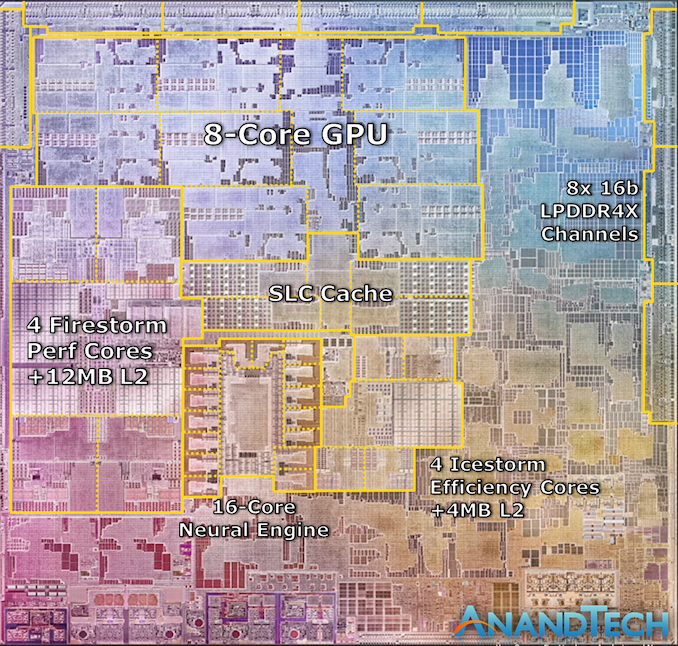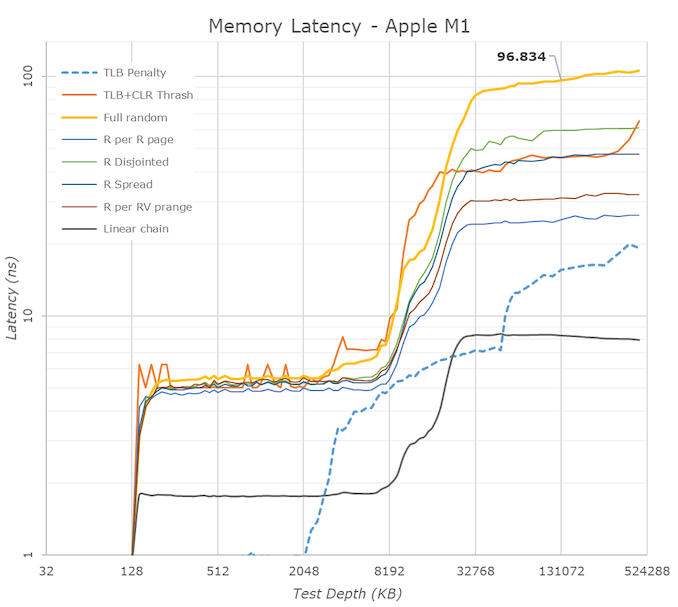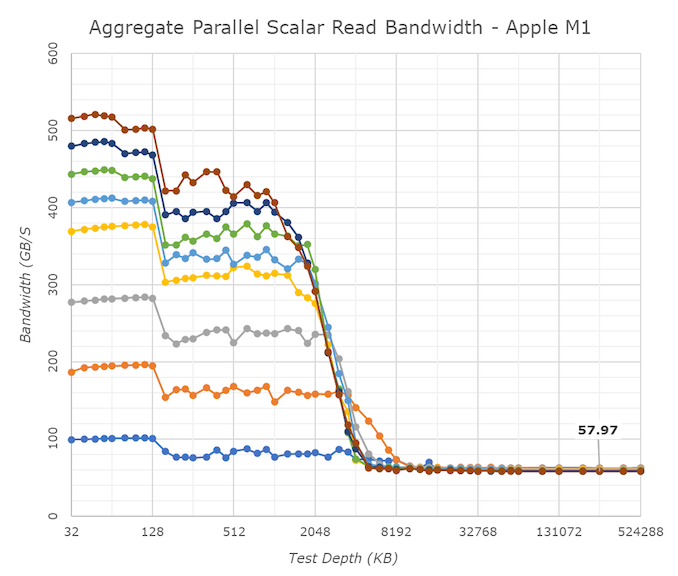The 2020 Mac Mini Unleashed: Putting Apple Silicon M1 To The Test
by Andrei Frumusanu on November 17, 2020 9:00 AM EST
Last week, Apple made industry news by announcing new Mac products based upon the company’s new Apple Silicon M1 SoC chip, marking the first move of a planned 2-year roadmap to transition over from Intel-based x86 CPUs to the company’s own in-house designed microprocessors running on the Arm instruction set.
During the launch we had prepared an extensive article based on the company’s already related Apple A14 chip, found in the new generation iPhone 12 phones. This includes a rather extensive microarchitectural deep-dive into Apple’s new Firestorm cores which power both the A14 as well as the new Apple Silicon M1, I would recommend a read if you haven’t had the opportunity yet:
Since a few days, we’ve been able to get our hands on one of the first Apple Silicon M1 devices: the new Mac mini 2020 edition. While in our analysis article last week we had based our numbers on the A14, this time around we’ve measured the real performance on the actual new higher-power design. We haven’t had much time, but we’ll be bringing you the key datapoints relevant to the new Apple Silicon M1.
Apple Silicon M1: Firestorm cores at 3.2GHz & ~20-24W TDP?
During the launch event, one thing that was in Apple fashion typically missing from the presentation were actual details on the clock frequencies of the design, as well as its TDP which it can sustain at maximum performance.
We can confirm that in single-threaded workloads, Apple’s Firestorm cores now clock in at 3.2GHz, a 6.66% increase over the 3GHz frequency of the Apple A14. As long as there's thermal headroom, this clock also applies to all-core loads, with in addition to 4x 3.2GHz performance cores also seeing 4x Thunder efficiency cores at 2064MHz, also quite a lot higher than 1823MHz on the A14.
Alongside the four performance Firestorm cores, the M1 also includes four Icestorm cores which are aimed for low idle power and increased power efficiency for battery-powered operation. Both the 4 performance cores and 4 efficiency cores can be active in tandem, meaning that this is an 8-core SoC, although performance throughput across all the cores isn’t identical.
The biggest question during the announcement event was the power consumption of these designs. Apple had presented several charts including performance and power axes, however we lacked comparison data as to come to any proper conclusion.
As we had access to the Mac mini rather than a Macbook, it meant that power measurement was rather simple on the device as we can just hook up a meter to the AC input of the device. It’s to be noted with a huge disclaimer that because we are measuring AC wall power here, the power figures aren’t directly comparable to that of battery-powered devices, as the Mac mini’s power supply will incur a efficiency loss greater than that of other mobile SoCs, as well as TDP figures contemporary vendors such as Intel or AMD publish.
It’s especially important to keep in mind that the figure of what we usually recall as TDP in processors is actually only a subset of the figures presented here, as beyond just the SoC we’re also measuring DRAM and voltage regulation overhead, something which is not included in TDP figures nor your typical package power readout on a laptop.

Starting off with an idle Mac mini in its default state while sitting idle when powered on, while connected via HDMI to a 2560p144 monitor, Wi-Fi 6 and a mouse and keyboard, we’re seeing total device power at 4.2W. Given that we’re measuring AC power into the device which can be quite inefficient at low loads, this makes quite a lot of sense and represents an excellent figure.
This idle figure also serves as a baseline for following measurements where we calculate “active power”, meaning our usual methodology of taking total power measured and subtracting the idle power.
During average single-threaded workloads on the 3.2GHz Firestorm cores, such as GCC code compilation, we’re seeing device power go up to 10.5W with active power at around 6.3W. The active power figure is very much in line with what we would expect from a higher-clocked Firestorm core, and is extremely promising for Apple and the M1.
In workloads which are more DRAM heavy and thus incur a larger power penalty on the LPDDR4X-class 128-bit 16GB of DRAM on the Mac mini, we’re seeing active power go up to 10.5W. Already with these figures the new M1 is might impressive and showcases less than a third of the power of a high-end Intel mobile CPU.
In multi-threaded scenarios, power highly depends on the workload. In memory-heavy workloads where the CPU utilisation isn’t as high, we’re seeing 18W active power, going up to around 22W in average workloads, and peaking around 27W in compute heavy workloads. These figures are generally what you’d like to compare to “TDPs” of other platforms, although again to get an apples-to-apples comparison you’d need to further subtract some of the overhead as measured on the Mac mini here – my best guess would be a 20 to 24W range.
Finally, on the part of the GPU, we’re seeing a lower power consumption figure of 17.3W in GFXBench Aztec High. This would contain a larger amount of DRAM power, so the power consumption of Apple’s GPU is definitely extremely low-power, and far less than the peak power that the CPUs can draw.
Memory Differences
Besides the additional cores on the part of the CPUs and GPU, one main performance factor of the M1 that differs from the A14 is the fact that’s it’s running on a 128-bit memory bus rather than the mobile 64-bit bus. Across 8x 16-bit memory channels and at LPDDR4X-4266-class memory, this means the M1 hits a peak of 68.25GB/s memory bandwidth.
In terms of memory latency, we’re seeing a (rather expected) reduction compared to the A14, measuring 96ns at 128MB full random test depth, compared to 102ns on the A14.
Of further note is the 12MB L2 cache of the performance cores, although here it seems that Apple continues to do some partitioning as to how much as single core can use as we’re still seeing some latency uptick after 8MB.
The M1 also contains a large SLC cache which should be accessible by all IP blocks on the chip. We’re not exactly certain, but the test results do behave a lot like on the A14 and thus we assume this is a similar 16MB chunk of cache on the SoC, as some access patterns extend beyond that of the A14, which makes sense given the larger L2.
One aspect we’ve never really had the opportunity to test is exactly how good Apple’s cores are in terms of memory bandwidth. Inside of the M1, the results are ground-breaking: A single Firestorm achieves memory reads up to around 58GB/s, with memory writes coming in at 33-36GB/s. Most importantly, memory copies land in at 60 to 62GB/s depending if you’re using scalar or vector instructions. The fact that a single Firestorm core can almost saturate the memory controllers is astounding and something we’ve never seen in a design before.
Because one core is able to make use of almost the whole memory bandwidth, having multiple cores access things at the same time don’t actually increase the system bandwidth, but actually due to congestion lower the effective achieved aggregate bandwidth. Nevertheless, this 59GB/s peak bandwidth of one core is essentially also the speed at which memory copies happen, no matter the amount of active cores in the system, again, a great feat for Apple.
Beyond the clock speed increase, L2 increase, this memory boost is also very likely to help the M1 differentiate its performance beyond that of the A14, and offer up though competition against the x86 incumbents.
- Page 1: Apple Silicon M1: Recap, Power Consumption
- Page 2: Benchmarks: Whatever Is Available
- Page 3: M1 GPU Performance: Integrated King, Discrete Rival
- Page 4: SPEC2006 & 2017: Industry Standard - ST Performance
- Page 5: SPEC2017 - Multi-Core Performance
- Page 6: Rosetta2: x86-64 Translation Performance
- Page 7: Conclusion & First Impressions













682 Comments
View All Comments
Ppietra - Friday, November 27, 2020 - link
ARM was really founded as a joint venture between Apple, Acorn and another company.The technology behind it was based on technology from Acorn, but the company was established as a joint venture to develop the processor for Newton. That was the objective for the company creation.
darwinosx - Wednesday, November 18, 2020 - link
Money talks and bullshit walks.lilmoe - Tuesday, November 17, 2020 - link
Not sure how you came to this conclusion with such a poor and unprofessional review. It seemed to me that AMD is killing it on all fronts, but the folks here made it really hard to tell with all these purposefully misleading charts.AMD wins. Come 5nm with Zen4 on laptops, poof goes all the drivel currently in the tech media.
It's disappointing to see this from Andre non-the-less. Very poor quality, and very misleading benchmarks.
ws3 - Tuesday, November 17, 2020 - link
Stage One: denialHifihedgehog - Tuesday, November 17, 2020 - link
Stage One: Comparing Apples to Apples, or 5nm to 5nm. AMD 7nm Zen 2, not even their latest and greatest, is doing admirably against a 5nm product. Pit Zen 3, still held back by 7nm, against it which is a good deal faster than Zen 2 and you have a totally different outcome. Pit Zen 4 where the Zen microarchitecture is given the legs to run with 5nm and it's no contest.defferoo - Tuesday, November 17, 2020 - link
show me a 5nm Zen 4 CPU to test against then, oh, it doesn't exist. I guess we can't do that comparison yet. what matters here is availability, and Zen 4 won't come for another year, M1 is here now.the closest thing to apples to apples now is to use the same TDP for comparison. stack up the Ryzen 7 4800U against the M1 in a Macbook Pro (~15W). M1 is faster in both ST and MT despite the 4800U having 8 cores with SMT.
when AMD was kicking Intel's butt on the 7nm process and Intel was on 14nm, nobody said, "but you need to compare like to like!" except for Intel fans. now it's Intel/AMD vs. Apple, and only those in denial are demanding a fair comparison on the same process node.
YesYesNo - Tuesday, November 17, 2020 - link
I don't see the M1 having faster multicore than the 4800U, which benchmark am i missing?Kuhar - Wednesday, November 18, 2020 - link
You are absolutely right! All that hype around M1 was just overexaggerated.defferoo - Wednesday, November 18, 2020 - link
Spec2017 MT in this very article, Geekbench. We should not over index on one very specific benchmark (Cinebench r23) when we have more comprehensive ways to measure performance.halo37253 - Tuesday, November 17, 2020 - link
Actually the Ryzen 4800U is not only beating the M1 in MultiThread in cinebench. But doing so with similar power usage. This is Zen2. Zen 3 will easily compete with apple silicon in terms of performance/watt, and in most cases beat it. At 7nm no less. Only makes we wonder why Apple is so willing to fracture their already pretty small Mac OS fanbase.The 4800U in 15w mode uses around 20-25watts of power running cinebench, vs the m1 using around 22watts. Sure it doesn't have the lead in single thread performance, but pretty close when the m1 is running x86 apps. Zen3 as we know is a massive improvement in this area. And the 4800U single thread wise is largely clock limited to keep it in check power usage wise.
I just dont see apple beating out AMD any time soon.
The 4800u still uses GCN graphic cores, so expect a huge gain when they move up to RDNA or RDNA2 (Hopefully they jump to 2).
Apple does have years of experience building tightly integrated SOCs, and this is where this chip shines. It clearly shows how well ARM can perform. But this is about as cutting edge as apple has been able to get their chip. AMD's focus is still mostly on the data center, so the fact their mobile devices do so well is a testament to how well suited Zen is to scale down.
Geekbench is a joke of a benchmark and was only ever good comparing devices in the same family. There is wide score changes with the same hardware when taking into the OS its running on. Never use it to compare different CPU Archs or even two different operation systems.